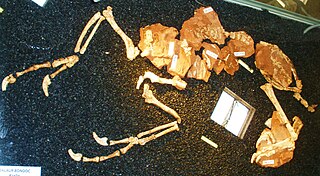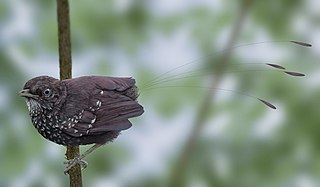
Jinzhousaurus is a genus of hadrosauroid dinosaur of the Early Cretaceous of China. The type species is Jinzhousaurus yangi. The generic name refers to the town Jinzhou. The specific name honours Yang Zhongjian as the founder of Chinese paleontology. It was first described by Wang Xiao-lin and Xu Xing in 2001.

Jeholosaurus is a genus of neornithischian dinosaur from the Early Cretaceous Period. It is thought to have been a herbivorous small ornithopod.

Jeholornis is a genus of avialans that lived between approximately 122 and 120 million years ago during the early Cretaceous Period in China. Fossil Jeholornis were first discovered in the Jiufotang Formation in Hebei Province, China and additional specimens have been found in the older Yixian Formation.

Eosipterus is an extinct genus of ctenochasmatid pterosaur from the Early Cretaceous period of Liaoning, China. Fossil remains of Eosipterus dated back to the Aptian stage of the Early Cretaceous, 124.6 million years ago.

Yandangornis is a genus of theropods from the Late Cretaceous. It lived 81.5 million years ago in what is now China. The type species, Y. longicaudus, was formally described by Cai and Zhou in 1999. The holotype specimen is a mostly complete skeleton in the collection of the Zhejiang Museum of Natural History, with accession number M1326. The fossil was discovered in 1986, near Linhai City in Zhejiang Province, China. It includes most of one complete skeleton. The genus was named after the Yandang mountains.

Longipteryx is a genus of prehistoric bird which lived during the Early Cretaceous. It contains a single species, Longipteryx chaoyangensis. Its remains have been recovered from the Jiufotang Formation at Chaoyang in Liaoning Province, China. Apart from the holotype IVPP V 12325 - a fine and nearly complete skeleton — another entire skeleton and some isolated bones are known to date.

Sapeornis is a monotypic genus of avialan which lived during the early Cretaceous period. Sapeornis contains only one species, Sapeornis chaoyangensis.

Hongshanornis is a genus of ornithuromorph birds known from early Cretaceous lake deposits of the Yixian Formation, Inner Mongolia, China. The holotype specimen, recovered in 2005, is currently held by the Institute of Vertebrate Paleontology and Paleoanthropology in Beijing. It was found in the Jianshangou fossil beds, dated to 124.6 million years ago. Three additional specimens have been reported, though only one of those has been definitively identified as belonging to Hongshanornis. This latter specimen was found in the Dawangzhangzi fossil beds, which are about 122 million years old.

Confuciusornithidae is an extinct family of pygostylian avialans known from the Early Cretaceous, found in northern China. They are commonly placed as a sister group to Ornithothoraces, a group that contains all extant birds along with their closest extinct relatives. Confuciusornithidae contains four genera, possessing both shafted and non-shafted (downy) feathers. They are also noted for their distinctive pair of ribbon-like tail feathers of disputed function.
Eocathayornis is a genus of enantiornithean birds that was probably more basal or "primitive" than related genera Sinornis and Cathayornis. These birds lived during the Early Cretaceous in today's People's Republic of China.

Pygostylia is a group of avialans which includes the Confuciusornithidae and all of the more advanced species, the Ornithothoraces.

Eoconfuciusornis a genus of extinct avialan that lived 131 Ma ago, in the Early Cretaceous of China.
Shenqiornis is a bird genus of the Enantiornithes. It was found in the Qiaotou Member of the Huajiying Formation of Hebei Province, China, and is therefore of uncertain age. The Qiaotou Member may correlate with the more well-known Early Cretaceous Yixian Formation, and so probably is dated to the Aptian, around 122 million years ago.

Balaur bondoc is a species of theropod dinosaur from the late Cretaceous period, in what is now Romania. It is the type species of the monotypic genus Balaur, after the balaur, a dragon of Romanian folklore. The specific name bondoc means "stocky", so Balaur bondoc means "stocky dragon" in Romanian. This name refers to the greater musculature that Balaur had compared to its relatives. The genus, which was first described by scientists in August 2010, is known from two partial skeletons.

Bohaiornithidae is a group of early predatory enantiornitheans from the early Cretaceous Period of China. All known specimens come from the Jiufotang Formation and Yixian Formation, dating to the early Aptian age, 125–120 million years ago. Bohaiornithidae was first coined as a family of enantiornithean birds by Wang and colleagues in 2014. They defined it as the natural group formed by all descendants of the common ancestor of the type species, Bohaiornis guoi, and Shenqiornis mengi.

Longusunguis is an extinct genus of bohaiornithid enantiornithean dinosaur known from the Early Cretaceous of Liaoning Province, northeastern China. It contains a single species, Longusunguis kurochkini.
Dunhuangia is a bird genus, belonging to the Enantiornithes, which during the Early Cretaceous lived in the area of present China.

Eogranivora is a bird genus, belonging to the Ornithuromorpha, that lived in the area of present-day China during the Early Cretaceous. Its type species is Eogranivora edentulata.

Fukuipteryx is an extinct genus of basal avialan dinosaurs found in Early Cretaceous deposits from Japan's Kitadani Formation. It contains one species, Fukuipteryx prima.

Parvavis is a genus of enantiornithine bird, known from the upper Cretaceous of China in the Jiangdihe Formation. The type and only species, Parvavis chuxiongensis, was recovered in Luojumei Village, Chuxiong City, Yunnan Province, southern China, and it was the only known Mesozoic bird from south China at the time of its discovery. Based on its bone structure, the holotype was determined to be nearly fully grown at its time of death and would have been smaller than Iberomesornis, the smallest known enantiornithine prior to the description of Parvavis.
































